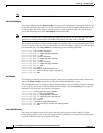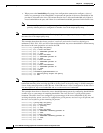
24-19
Cisco ASR 901 Series Aggregation Services Router Software Configuration Guide
OL-23826-09
Chapter 24 Configuring QoS
Understanding QoS
Router(config)# interface gigabitethernet0/1
Router(config-if)# service-policy input Example
Router(config-if)# exit
Congestion Management and Scheduling
Cisco Modular QoS CLI (MQC) provides several related mechanisms to control outgoing traffic flow.
They are implemented in output policy maps to control output traffic queues. The scheduling stage holds
packets until the appropriate time to send them to one of the four traffic queues. Queuing assigns a packet
to a particular queue based on the packet class. You can use different scheduling mechanisms to provide
a guaranteed bandwidth to a particular class of traffic while also serving other traffic in a fair way. You
can limit the maximum bandwidth that can be consumed by a particular class of traffic and ensure that
delay-sensitive traffic in a low latency queue is sent before traffic in other queues.
The Cisco ASR 901 router supports these scheduling mechanisms:
• Traffic shaping
Use the shape average policy map class configuration command to specify that a class of traffic
should have a maximum permitted average rate. You specify the maximum rate in bits per second.
• Class-based-weighted-fair-queuing (CBWFQ)
Use the bandwidth policy-map class configuration command to control the bandwidth allocated to
a specific class. Minimum bandwidth can be specified as percentage.
• Priority queuing or class-based priority queuing
Use the priority policy-map class configuration command to specify the priority of a type of traffic
over other types of traffic. You can specify strict priority for the high-priority traffic and allocate any
excess bandwidth to other traffic queues, or specify priority with unconditional policing of
high-priority traffic and allocate the known remaining bandwidth among the other traffic queues.
–
To configure strict priority, use only the priority policy-map class configuration command to
configure the priority queue. Use the bandwidth remaining percent policy-map class
configuration command for the other traffic classes to allocate the excess bandwidth in the
desired ratios.
–
To configure priority with unconditional policing, configure the priority queue by using the
priority policy-map class configuration command and the police policy-map class
configuration command to unconditionally rate-limit the priority queue. In this case, you can
configure the other traffic classes with bandwidth or shape average, depending on
requirements.
These sections contain additional information about scheduling:
• Traffic Shaping, page 24-19
• Class-Based Weighted Fair Queuing, page 24-21
• Priority Queuing, page 24-23
Traffic Shaping
Traffic shaping is a traffic-control mechanism similar to traffic policing. While traffic policing is used
in input policy maps, traffic shaping occurs as traffic leaves an interface. The router can apply
class-based shaping to classes of traffic leaving an interface and port shaping to all traffic leaving an
interface. Configuring a queue for traffic shaping sets the maximum bandwidth or peak information rate
(PIR) of the queue.


















